very good
I expected go Down to at level 61.8 at 1.32220 on weekly chart
Forum on trading, automated trading systems and testing trading strategies
newdigital, 2014.07.26 18:19
Key Fundamental Releases this Week (7/28-8/1)
Last week the USD strengthened in anticipation of this week’s FOMC
meeting. The market has replaced concerns that stemmed from poor Q1 GDP
with USD-positive reactions to Q2 data, which have been in-line or
better than expectations. The euro was a big loser last week as data
continues to suggest the ECB might need further stimulus (QE). This week
will be full of key US fundamentals. Let’s be prepared by taking a look
at this week’s key fundamental releases for the majors.
Monday (7/28)
US Pending Home Sales for June, is forecast to have contracted at
-0.2%. Pending home sales have been volatile and just came off a 6.1%
gain in May. A slide in June is not the end of the world. We had 3
straight months of gains, which is something we have not seen since
2010. On the other hand, a positive reading could be USD-positive in the
near-term, given it has not already rallied sharply before the housing
data.
Tuesday (7/29)
US Conference Board Consumer Confidence for July is expected to edge
up to 85.5 from 85.2. This reading would reflect the strongest reading
since January 2008. It has risen sharply since the Jan. 2013 low of 58.6
and bodes well for the USD. A reading in line with forecast or better
should keep the USD-buoyed. A reading below 85.0 might weigh slightly on
the USD, but we should keep the implications in the intra-session
time-frame.
Wednesday (7/30)
German Preliminary CPI for July is forecast to be 0.2% on the month,
after a 0.3% reading in June. The annual reading in June was 1.0%. If
the annual CPI reading for Germany falls below 1.0%, we might see some
more pressure on the EUR. A ready above 1.0% on the year could help EUR
consolidate, but should not be able to help EUR reverse its recent
downtrend.
US ADP Non-Farm Employment Change for July is a precursor to
Friday’s Non-Farm Payroll, which was hot last month. The ADP report was
hot last month too, and came in at 281K, which was the strongest reading
since December 2011, and was the 3rd strongest reading since the
financial crisis. Economists are expecting July’s job market to have
leveled off, and to have added 234K jobs, which is still a strong
reading.
US Advanced GDP for Q2 will probably trump the jobs data in terms of
importance. Q1 GDP was -2.9% at an annualized rate. This seems distant
memory now. We can’t blame the weather anymore in the second quarter,
and manufacturing, sales, and other economic data points for Q2 have not
disappointed. Economists forecast a 3.1% advanced reading. Ability to
show 3.0% and above should help the USD maintain its recent strength. A
reading below 3.0% could be seen as disappointing, and might urge
traders to pare USD’s recent gains.
The Federal Open Market Committee will conclude its monetary
policy meeting and make a statement. It will have the GDP data to talk
about. This is important because after Q1′s dismal growth data, the Fed
showed concern about Q2 data. The market will be on top of the Fed’s
reaction to the Q2 GDP and how it may affect the rate hike time-line,
which is current projected to mid-2015.
Australian Building Approvals for June is forecast to have grown
0.2%, after a strong 9.9% reading in May.The AUD has regained some
strength after seeing Australia’s annual CPI inflation grow from 2.9%
to 3.0% in Q2. The housing data should have limited impact on the
Aussie.
Thursday (7/31)
Eurozone CPI Flash Estimate for July is forecast to be 0.5% on the
year. It has been stuck at 0.5% since May. ECB president Mario Draghi
had predicted that inflation was at the bottom when it was 0.5% in
February. So far, his prediction has neither materialized or been
invalidated because the annual CPI inflation is still 0.5%. A drop
below 0.5% will very likely weigh on the EUR because the ECB’s inaction
is based on inflation not dropping further. a drop in inflation will be
further impetus for the ECB to apply more monetary stimulus.
Eurozone’s unemployment rate is expected to stay at 11.6% for the
month of July. There is more room for disappointment because the
prevailing trend has been a steady improvement, and if the reading is
11.5% for example, it would not be such a big surprise. A reading of
11.7% however will buck the trend and provide the ECB with more reason
to loosen monetary policy further.
Canadian GDP for the month of May is forecast to be 0.3%, which
would be the strongest month since January when it was 0.5%. The
monthly GDP was 0.1% for April and March. There has not been any
negative readings so far this year. If we can keep that up, the CAD
should maintain its recent strength (though it consolidated for a couple
of weeks). A negative reading might be needed to hold CAD back and
keep it in consolidation or bearish correction. A reading above 0.5%
can definitely revive CAD-strength.
US Jobless claims was at a 10-year low this week, at 284K. Next
week’s reading is expected to rise back to 306K which would still be at
the lower range of 2014-data. A reading below 300K should be positive
for the USD in the near-term. A reading above 320K might be needed to
hold USD, but only in the intra-session time-frame. This assessment is
assuming that the FOMC did not shake things up and put the USD in a
medium term bearish outlook. We are assuming the USD continues to be
bullish.
Chinese Manufacturing PMI for July provided by the government, is
expected to improve to 51.4 from 51.0. This would reflect 5 straight
months of steady improvement in manufacturing, and also reflects the
quick recovery after we saw Chinese data slump in 2013. The final
version of HSBC’s Chinese Manufacturing PMI is expected to be 52.0,
which would also reflect the recovery in China’s economy.
Australia’s Producer Price Index is forecast to show inflation of
0.7% in Q2, down from 0.9% in Q1. Q1 PPI inflation compared to Q1 2013
was 2.5%. If this reading increases, we might see some AUD-strength,
and if it declines we should see AUD consolidate. It is still too early
to anticipate any economic data point to be able to put AUD into
reversal, into a bearish market.
Friday (8/1)
UK Manufacturing PMI for July is forecast to be 57.2, slightly
lower than the 57.5 reading in June. This is a second tier data point
and shouldn’t have much impact on the GDP other than in the very
near-term. The market is focused on whether the Bank of England can
raise rates in 2014. Right now lack of wage growth is the concern, so
even a strong improvement in manufacturing will not ease that concern,
nor should a singular worse-than-expected reading add to that concern.
US Non-Farm Payroll report for July will be the key data point to
wrap up the week. The 288K reading for June revived USD strength.
Economists expect about a 230K reading, which is still decent. A
reading above 200K is decent, and if it is above 250K, the Fed should
have more reason to raise rates earlier than mid-2015 rather than
after. A reading below 200K however might bring USD back into at least
some short-term consolidation, especially if it has been gaining
throughout the week.
very good
I expected go Down to at level 61.8 at 1.32220 on weekly chart
I think it will be ranging bearish - look at D1 timeframe : stochastic and schaff indicators are on oversold level:
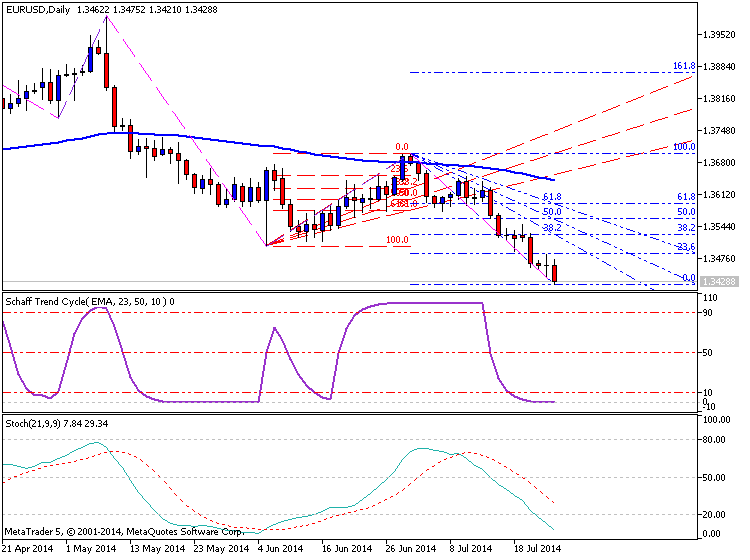
About W1 timeframe - we see the price for crossing Moving Averages indicator with the period 100 :
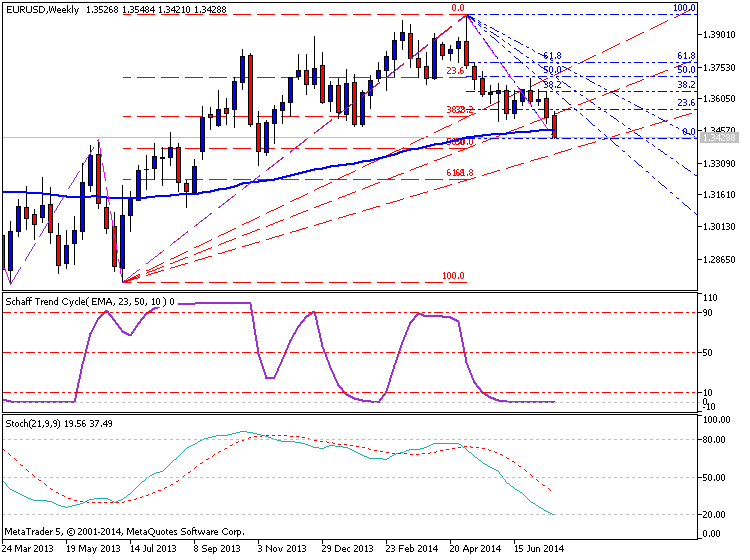
But if we look at SMA 50/200 crossing (see image below) so we see that it was not bearish condition on D1 timeframe- it was secondary correction within primary bullish: directional SMA with period 200 is indicating uptrend, and Stochastic indicator is on oversold level -
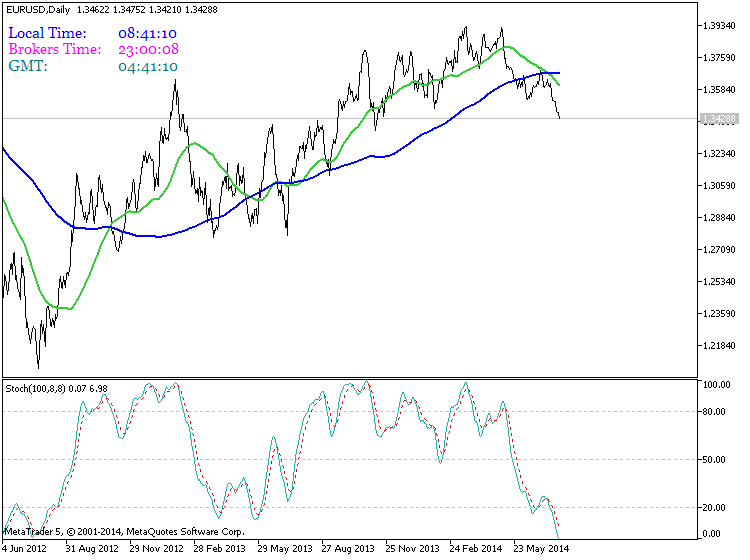
So, it will be ranging week for EURUSD.
Forum on trading, automated trading systems and testing trading strategies
newdigital, 2014.07.27 09:50
Forex Weekly Outlook Jul 28-Aug 1US Housing data, ADP Non-Farm Employment Change, GDP figures in the US and Canada, US rate decision and Non-Farm Payrolls are the main market movers this week. Here is an outlook on the major events coming our way.
Last week, the number of US jobless claims fell to 284K, the lowest level in nearly 8-1/2 years, indicating the labor market recovery is picking up. The 19,000 fall was contrary to analysts’ expectations of a rise to 308,000. The four-week average declined by 7,250 to 302,000, falling to the lowest level since May 2007. The US economy continues to improve suggesting the Fed may raise rates sooner than planned. Will we see a rate hike in 2014?
- US Pending Home Sales: Monday, 14:00. The number of contracts to purchase existing U.S. homes surged in May by 6.1%, the biggest climb since April 2010. The reading was far better than the 1.4% addition predicted by analysts, showing a strong rebound in the housing market. Stronger employment conditions as well as cheaper borrowing costs, enable the pick-up in the housing sector. Pending sales are expected to decline 0.2% this time.
- US CB Consumer Confidence: Tuesday, 14:00. U.S. consumer confidence edged up in June to 85.2 following a downwardly revised 82.2 in May, posting the highest reading since January 2008. Economists expected a smaller rise to 83.6. The expectations index increased to 85.2 in June from 83.5 in May, while the current situation index improved to 85.1 versus 80.3 in May. A further rise to 85.5 is expected now.
- US ADP Non-Farm Employment Change: Wednesday, 12:15. Private sector employment increased by 281,000 workers in June from 179,000 in May, according to the ADP report. Economists’ expected a modest rise of 207,000 jobs. The strong reading reflects continued strengthening in the labor market with a pick-up in Job creation. Private sector employment is expected to expand by 234,000.
- US GDP data: Wednesday, 12:30. Advance GDP, the earliest GDP measure released in April showed an annual growth pace of 0.1% in the first quarter, falling behind expectations for a 1.2% climb. Weather conditions and sluggish exports, housing and business investment were the main contributors for the shabby growth rate. The Preliminary GDP reading is predicted to reach 3.1%.
- FOMC Statement: Wednesday, 18:00. The Fed decisions released in June were in line with market expectations. Rates remained unchanged at a range of zero to 0.25% and taper continued on schedule. The Fed expressed concerned about the elevated unemployment rate, however noted an improvement in economic activity. The Committee voted to maintain accommodative stance of monetary policy to support growth. The FOMC downgraded its GDP forecast due to adverse weather in the first quarter.
- Canadian GDP: Thursday, 12:30. Canadian GDP Growth stalled in April, inching 0.1% as in the previous month, while expected to rise 0.2%. Wholesale and retail activity edged up mildly, while mining and construction output weakened. On a year-over-year bases gross domestic product expanded 2.1%, the same rate marked in the previous month. Canadian economy is expected to grow by 0.3%.
- US Unemployment claims: Thursday, 12:30. The US Labor market registered a decline of 19,000 claims for jobless benefits in the previous week; reaching 283,000.Analysts expected a rise to 307,000 in the number of claims. This was the lowest reading since February 2006. The four-week moving average declined by 7,250 to 302,000, from the previous week. This is the lowest average level since May 19, 2007. This week’s reading reinforces views that the US economy is matching forward. The number of unemployment claims is expected to reach 306,000.
- Haruhiko Kuroda speaks: Friday, 3:30. BOJ Governor Haruhiko Kuroda will speak in Tokyo. He may speak about the slowdown in inflation and his plans for the coming months.
- US Non-Farm Employment Change and US Unemployment Rate: Friday, 12:30. The US labor market showed a remarkable job Addition of 288,000 in June, the strongest reading since January 2012, following a gain of 217,000 in May. Analysts expected a weaker increase of 214,000. This was another sign that the US job market is strengthening parallel to the economic recovery. The unemployment rate fell to 6.1% from 6.3% registered in May, the lowest level since Sep. 2008. Analysts expected rates to remain unchanged at 6.3%. The US labor market is expected to increase by 230,000 jobs, while the unemployment rate is forecasted to remain unchanged at 6.1%.
- US ISM Manufacturing PMI: Friday, 14:00. In June, the ISM manufacturing index declined mildly to 55.3, from 55.4% recorded in May. The figure was a little below market forecast of 55.6. However, the index still indicates expansion in the manufacturing sector. Declines in production and in supplier deliveries were the main reason for the lukewarm rise. US manufacturing sector is expected to expand to 56.1.
I think it will be ranging bearish - look at D1 timeframe : stochastic and schaff indicators are on oversold level:
About W1 timeframe - we see the price for crossing Moving Averages indicator with the period 100 :
But if we look at SMA 50/200 crossing (see image below) so we see that it was not bearish condition on D1 timeframe- it was secondary correction within primary bullish: directional SMA with period 200 is indicating uptrend, and Stochastic indicator is on oversold level -
So, it will be ranging week for EURUSD.
I think it Will be bullish on weekly chart for these Reason
Month support (2) at 1.34359Forum on trading, automated trading systems and testing trading strategies
newdigital, 2014.07.27 16:47
EUR/USD forecast for the week of July 28, 2014, Technical Analysis
The EUR/USD pair fell during the course of the week, clearing the 1.35
level. It now appears that the selling momentum is picking up, and
heading down towards the 1.33 level. The 1.33 level as you can see is
marked on the chart as support, and we feel that the buyers could step
back into the marketplace at that area. Nonetheless, it does appear that
in the meantime we are going to continue falling, and a break below the
1.33 level would be very bearish. Because of this, we don’t have any
interest in buying.
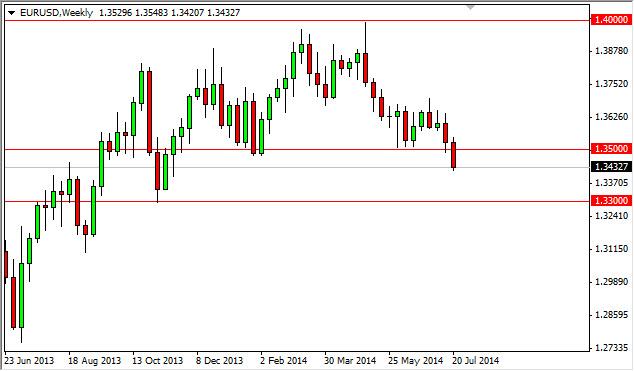
Forming crab pattern for uptrend (EURUSD, H4):
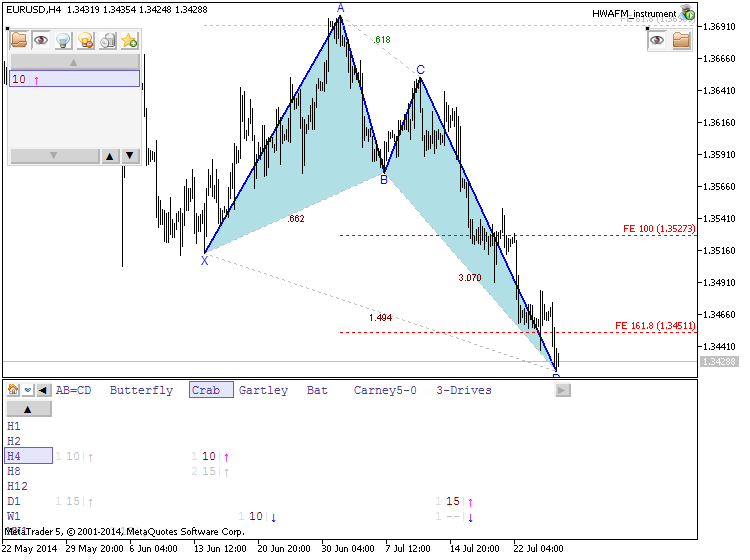
Forum on trading, automated trading systems and testing trading strategies
Something Interesting in Financial Video May 2014
newdigital, 2014.05.23 18:35
The Crab Pattern - Harmonic Ratios and Explanation :
The Deep Crab Pattern - Harmonic Ratios and Explanation :
Forum on trading, automated trading systems and testing trading strategies
newdigital, 2014.07.27 17:41
EUR/USD weekly outlook: July 28 - August 1The euro fell to eight month lows against the stronger dollar on Friday and was close to multi-month lows against the yen and the pound as concerns over the divergence in monetary policy between the European Central Bank and other central banks pressured the single currency lower.
EUR/USD was down 0.25% to 1.3429 at the close, reaching the lowest level since November. For the week, the pair lost 0.74%.
The pair is likely to find support at around 1.3400 and resistance at 1.3475.
The drop in the euro came after a report showed that Germany’s Ifo business climate index dropped to 108.0 in July, missing estimates for a reading of 109.4. It was the third consecutive monthly decline.
The data added concerns over the outlook for the euro zone’s largest economy. The euro has come under pressure since the ECB cut rates to record lows on June 5, in a bid to stave off the risk of deflation and shore up growth in the region.
Sentiment on the single currency was also hit by concerns that tougher sanctions on Russia would have a negative impact on the outlook for growth in the currency bloc, which has close trade ties with Moscow.
The greenback was boosted as better than expected data on durable goods orders for June added to signs that the U.S. economy is improving.
The Commerce Department reported a rise of 0.7% in orders of long lasting goods such as machinery and electronic products, compared to forecasts of 0.5%. Durable goods orders fell by 1.0% in May.
Demand for the dollar has been underpinned since Federal Reserve Chair Janet Yellen indicated earlier this month that U.S. interest rates could rise sooner if the recovery in the labor market continues.
Elsewhere Friday, EUR/JPY was down 0.23% to 136.75 late Friday, not far from the five month lows of 136.35 reached in the previous session.
EUR/GBP slid 0.18% to 0.7910, not far from Wednesday’s 22-month low of 0.7873.
In the week ahead investors will be focusing on U.S. data on second-quarter gross domestic product and an interest rate decision by the Federal Reserve on Wednesday, while Friday’s nonfarm payrolls report for July will also be closely watched.
The euro zone is to release preliminary data on consumer prices on Thursday.
Monday, July 28
- The U.S. is to release data on pending home sales.
- The U.S. is to publish reports on house price inflation and consumer confidence.
- In the euro zone, Germany is to release preliminary data on consumer price inflation, while Spain is to publish flash estimates on consumer inflation and second quarter economic growth.
- The U.S. is to release the ADP report on private sector job creation, which leads the government’s nonfarm payrolls report by two days. The U.S. is also to publish revised data on second quarter growth.
- Later Wednesday, the Federal Reserve is to announce its federal funds rate and publish its rate statement.
- The euro zone is to release preliminary data on consumer inflation and unemployment, while Germany is to publish data on retail sales and unemployment.
- The U.S. is to release the weekly report on initial jobless claims, as well as data on manufacturing activity in the Chicago area.
- The U.S. is to round up the week with what will be closely watched government data on nonfarm payrolls and the unemployment rate, while the Institute of Supply Management is to release data on manufacturing activity.
Forming crab pattern for uptrend (EURUSD, H4):
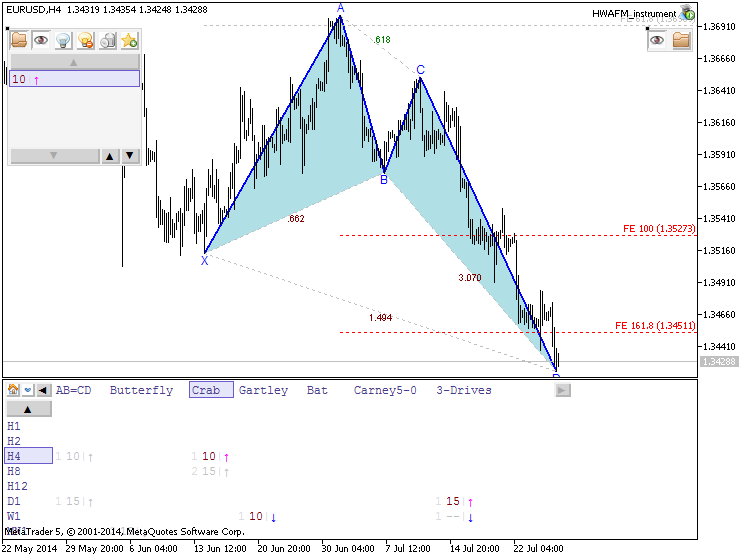
This is updated situation with this pattern: uptrend from 1.3428 to 1.3437:
MetaTrader Trading Platform Screenshots
MetaQuotes Software Corp., MetaTrader 5, Demo
temp_file_screenshot_59676.png

Forum on trading, automated trading systems and testing trading strategies
newdigital, 2014.07.28 15:19
Technical Setups For EUR/USD, USD/JPY, GBP/USD, AUD/USD - Credit Suisse (based on fxstreet article)
EUR/USD: EURUSD holds a bearish "wedge" and a “head & shoulders” top for 1.3374 initially, then 1.3248.
EURUSD continues to consolidate recent losses, and with minor resistance levels still as yet still unchallenged and a large bear "wedge" pattern and now also "head & shoulders" top in place, we stay directly bearish. We look for further weakness to 1.3399 initially, then the 50% retracement of the 2013/14 rise at 1.3374. We allow for a bounce here ahead of our target at 1.3248/28 – the 38.2% retracement of the entire 2012/2014 uptrend. While we would expect this to hold at first, bigger picture, we see scope for 1.2755.
Resistance shows at 1.3486/95 initially, above which can see a move back to 1.3531, with 1.3550/53 ideally capping to keep the immediate risk lower.
MetaTrader Trading Platform Screenshots
MetaQuotes Software Corp., MetaTrader 5, Demo
temp_file_screenshot_14840.png

- Free trading apps
- Over 8,000 signals for copying
- Economic news for exploring financial markets
You agree to website policy and terms of use
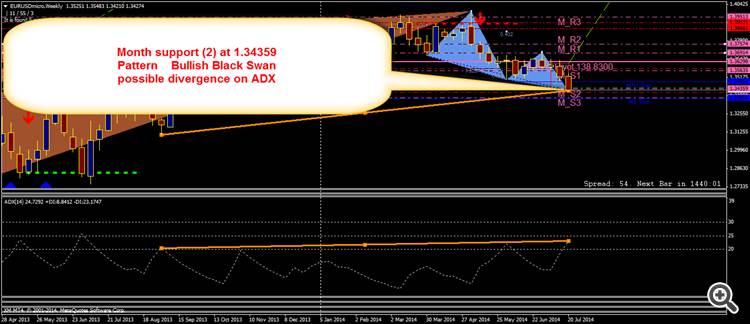
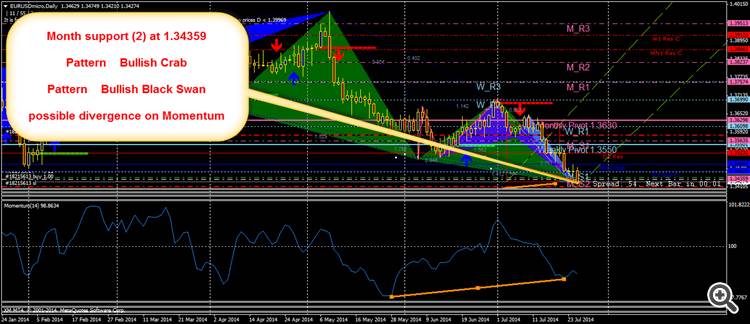
D1 price is on strong bearish with breaking 1.3437 support level.
W1 price is located inside Ichimoku cloud below Sinkou Span A line which is the vistual border between primary bullish and primary bearish market condition. W1 price was reversed to bearish and came to Ichimoku cloud for secondary ranging.
H4 price is on strong bearish with trying to break 1.3421 support.
If D1 price will break 1.3437 support level on close bar so the primary bearish will be continuing.
If not so we may see ranging market condition within primary bearish.
UPCOMING EVENTS (high/medium impacted news events which may be affected on EURUSD price movement for this coming week)
2014-07-28 14:00 GMT (or 16:00 MQ MT5 time) | [USD - Pending Home Sales]
2014-07-29 06:00 GMT (or 08:00 MQ MT5 time) | [EUR - German Import Prices]
2014-07-29 14:00 GMT (or 16:00 MQ MT5 time) | [USD - CB Consumer Confidence]
2014-07-30 07:00 GMT (or 09:00 MQ MT5 time) | [EUR - Spanish GDP]
2014-07-30 12:30 GMT (or 14:30 MQ MT5 time) | [USD - GDP]
2014-07-29 18:00 GMT (or 20:00 MQ MT5 time) | [USD - Federal Funds Rate]
2014-07-31 06:00 GMT (or 08:00 MQ MT5 time) | [EUR - German Retail Sales]
2014-07-31 07:55 GMT (or 09:55 MQ MT5 time) | [EUR - German Unemployment Change]
2014-07-31 09:00 GMT (or 11:00 MQ MT5 time) | [EUR - CPI Flash Estimate]
2014-07-31 12:30 GMT (or 14:30 MQ MT5 time) | [USD - Unemployment Claims]
2014-08-01 01:00 GMT (or 03:00 MQ MT5 time) | [CNY - Manufacturing PMI]
2014-08-01 01:45 GMT (or 03:45 MQ MT5 time) | [CNY - HSBC Manufacturing PMI]
2014-08-01 12:30 GMT (or 14:30 MQ MT5 time) | [USD - Non-Farm Employment Change]
2014-08-01 14:00 GMT (or 16:00 MQ MT5 time) | [USD - ISM Manufacturing PMI]
Please note : some US (and CNY) high/medium impacted news events (incl speeches) are also affected on EURUSD price movement
SUMMARY : bearish
TREND : ranging
Intraday Chart